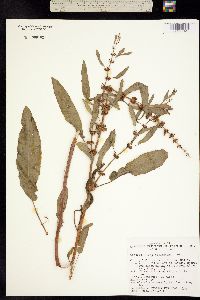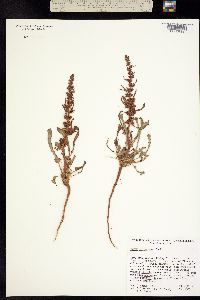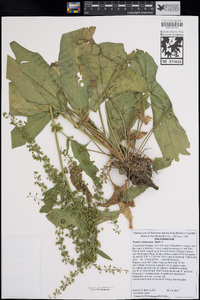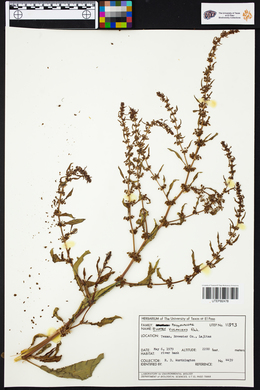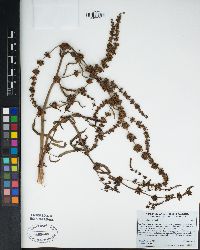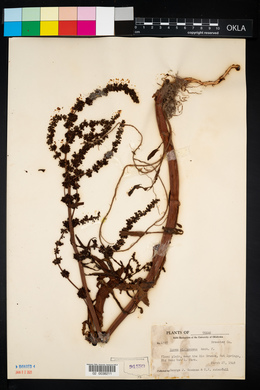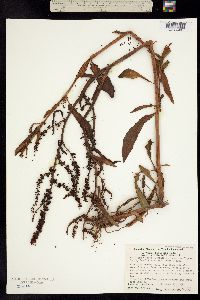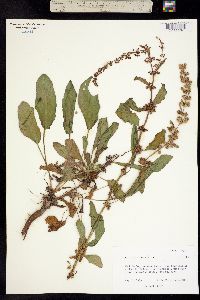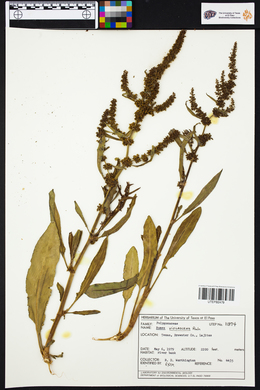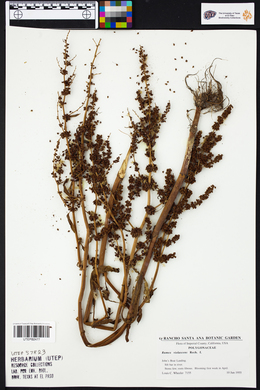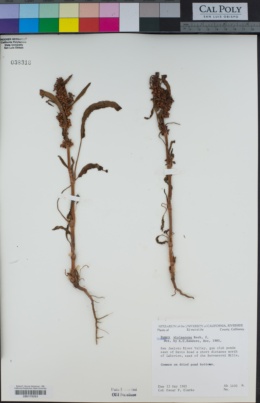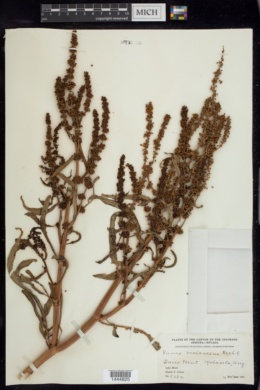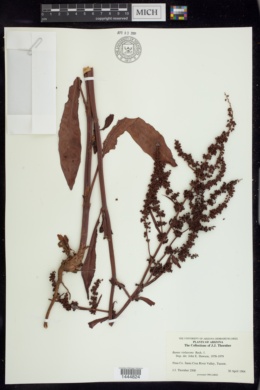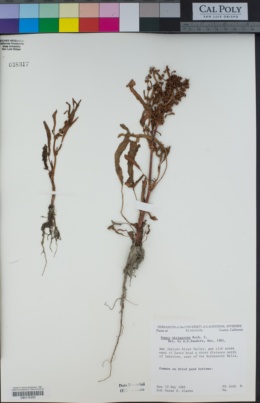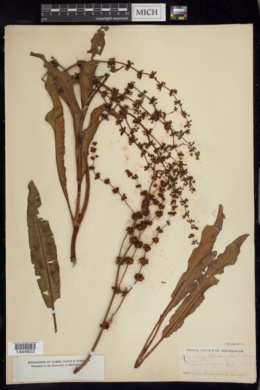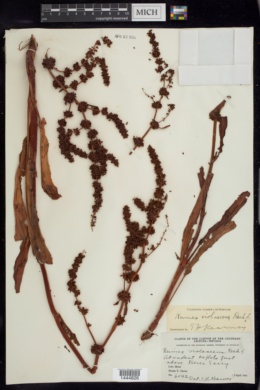Rumex violascens
|
|
|
|
Family: Polygonaceae
Violet Dock
|
Plants annual or biennial, sometimes short-lived perennial, glabrous, with fusiform, vertical or oblique rootstock. Stems erect, branched above middle, 25-75 cm. Leaves: ocrea deciduous or partially persistent at maturity; blade oblong-lanceolate to obovate-elliptic, 6-12(-15) × (2-)3-4(-5) cm, less than 4 times as long as wide, not coriaceous, occasionally subcoriaceous, base broadly cuneate or rounded, occasionally truncate, margins entire, flat or, rarely, weakly undulate, apex obtuse, rarely subacute. Inflorescences terminal, occupying distal 2 of stem, usually lax, interrupted, broadly paniculate; branches usually distinctly arcuate and flexuous. Pedicels articulated in proximal 3, filiform, 3-8 mm, articulation distinctly swollen. Flowers 10-20 in rather dense remote whorls; inner tepals deltoid or triangular-deltoid, 2.5-3.7(-4) × 2-2.8(-3) mm (excluding teeth), ca. 1.5 times as long as wide, base truncate, margins dentate or rarely subentire, apex acute to subacute, teeth 2-3, normally at each side of margins, triangular, 0.2-0.5 mm; tubercles 3, unequal or, occasionally, subequal, normally less than 2 times as wide as inner tepals. Achenes brown or reddish brown, 1.8-2.3 × 1.2-1.5 mm. 2n = 20. Flowering late spring-summer. Wet habitats along streams, river valleys; 0-500 m; Ariz., Calif., Mass., N.Mex., Tex.; n Mexico. The name Rumex berlandieri was misapplied to this species by some botanists who followed W. D. Trelease (1892). This native species is poorly known taxonomically; it probably is distantly related to Rumex obovatus and R. paraguayensis. Rumex flexicaulis Rechinger f., a species possibly conspecific with R. violascens, occurs in Mexico.
FNA 2005, Wiggins 1964, Kearney and Peebles 1969 Duration: Annual Nativity: Native Lifeform: Forb/Herb General: Erect annual, biennial, or perennial 40-80 cm tall, simple stems, branched above middle, with sheathing stipules 5-15 mm long. Leaves: Ocrea deciduous or partially persistent at maturity, blades oblong-lanceolate to obovate-elliptic 1-2.5 cm wide by 4-10 cm long, broadly cuneate to truncate at base, acute to obtuse at apex, margin faintly crispate or plane, on petiole 2-6 cm long; upper leaves reduced, subsessile. Flowers: Terminal paniclulate inflorescence, leafy, slender pedicels that are twice as long as fruiting valves, jointed near the base; flowers 10-20 in dense whorls, inner tepals deltoid or triangular-deltoid, 2.5-4 mm long, acute to obtuse, strongly reticulate-veined, base truncate, margins dentate or rarely subentire, apex acute to subacute, 2-3 teeth, normally at each side of margins; 3 tubercles, unequal, subequal, or less than 2 times as wide as inner tepals. Fruits: Brown or reddish brown achenes, 2-2.5 mm long. Ecology: Found in wet habitats along streams and in river valleys below 5,000 ft (1524 m); flowers April-July. Notes: The habitat is one cue to the determination of this species, as are the plane leaves, and the shallow dentations at the base of the valves of the fruit. Ethnobotany: Leaves were boiled and eaten. Etymology: Rumex is the Latin name for docks or sorrels, while violascens means becoming violet colored. Synonyms: None Editor: SBuckley, 2010 |










